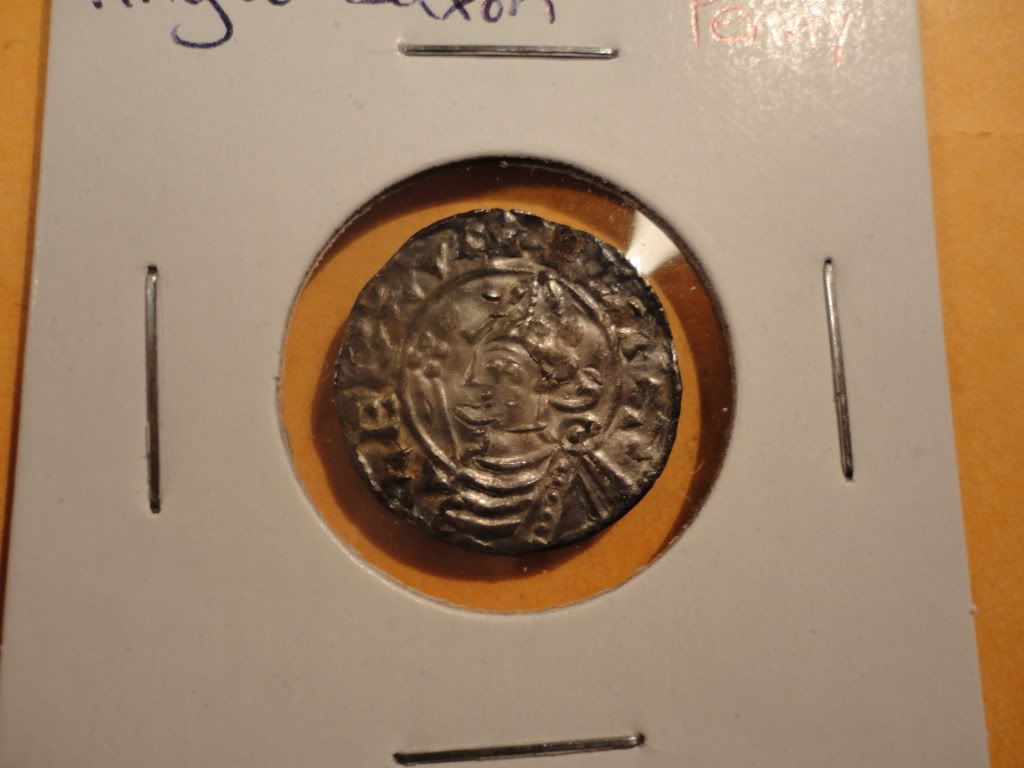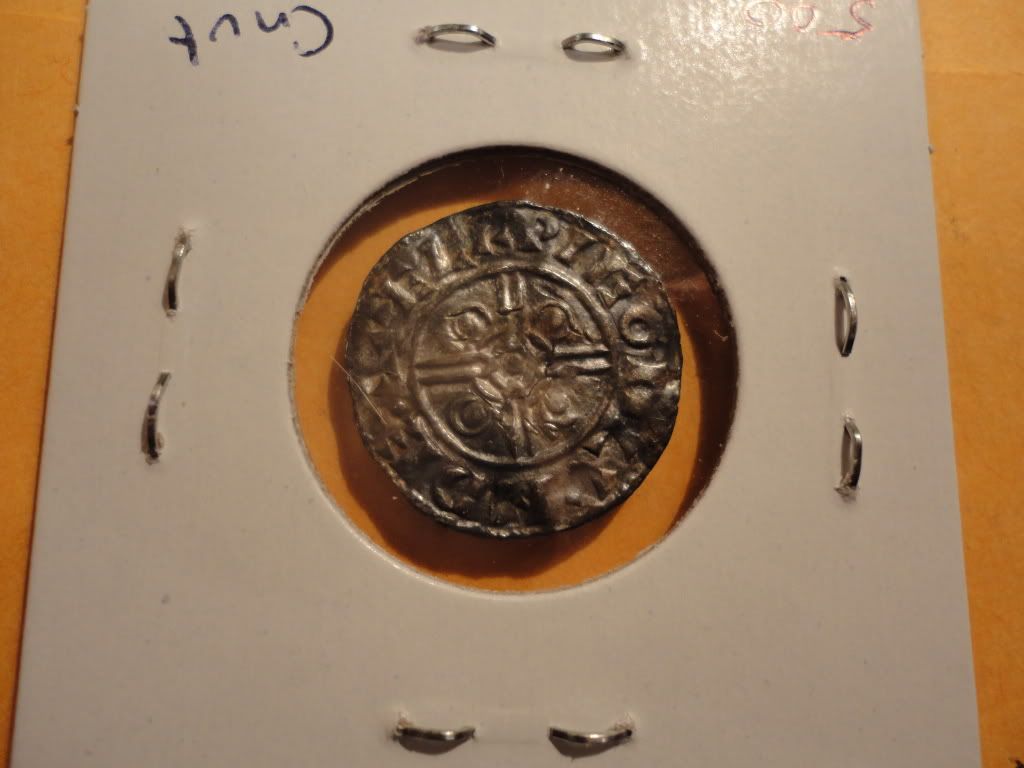Options
Anglo Saxon Silver Penny
 candy2012mustang
Posts: 479 ✭
candy2012mustang
Posts: 479 ✭
Hi Guys-
A fellow forum member recently posted pictures of Anglo Saxon coins from his collection on the forum. Ive been trying to identify this hammered silver coin for a while now, and after seeing the pictures of his coins I thought that this coin may also be Anglo Saxon. After a bit of research online it appears to be an Anglo Saxon Silver Penny. Does anybody have an exact ID?
Thanks!


A fellow forum member recently posted pictures of Anglo Saxon coins from his collection on the forum. Ive been trying to identify this hammered silver coin for a while now, and after seeing the pictures of his coins I thought that this coin may also be Anglo Saxon. After a bit of research online it appears to be an Anglo Saxon Silver Penny. Does anybody have an exact ID?
Thanks!


0
Comments
"Hello Kev,
Looks like a Cnut penny, pointed helmet type, London mint.
best,
keith"
Can anybody else verify this?
Can you make out the legend? Oh, and YorkCoins has several examples to compare it to if you don't have another reference.
<< <i>I got an email back from Keith at http://www.anglosaxoncoins.net/ saying:
"Hello Kev,
Looks like a Cnut penny, pointed helmet type, London mint.
best,
keith"
Can anybody else verify this?,
Kev, Yes I believe that is correct.
Not sure about the Mint ... you'll need to decipher the lettering on the Reverse for that.
My World Coin Type Set
<< <i>I'll place another vote for Cnut, Spink-1158, Pointed Helmet. See a similar coin from Heritage.
Not sure about the Mint ... you'll need to decipher the lettering on the Reverse for that. >>
It reads LVNDE which is London.
<< <i>
<< <i>I'll place another vote for Cnut, Spink-1158, Pointed Helmet. See a similar coin from Heritage.
Not sure about the Mint ... you'll need to decipher the lettering on the Reverse for that. >>
It reads LVNDE which is London. >>
Wow, you are much better at recognizing the lettering than I am. I can only see the letters after someone tells me what they are.
My World Coin Type Set
I agree - Spink1158.
Very nice!
<< <i>Wow, looks like a nice one, too. That one's gonna be worth a wee bit, most likely.
$150-200, no more. It has a crack in the middle and the legend isn't very clear. Combine that with a common mint and there isn't much upside. Cnut being the commonest of the Saxon kings means you can always get a decent example for say twice this amount.
<< <i>
<< <i>Wow, looks like a nice one, too. That one's gonna be worth a wee bit, most likely.
$150-200, no more. It has a crack in the middle and the legend isn't very clear. Combine that with a common mint and there isn't much upside. Cnut being the commonest of the Saxon kings means you can always get a decent example for say twice this amount. >>
Maybe a little better, $250 or $300 is about where I've seen them lately. The flan crack seems minimal on this one.
<< <i>
<< <i>
<< <i>Wow, looks like a nice one, too. That one's gonna be worth a wee bit, most likely.
$150-200, no more. It has a crack in the middle and the legend isn't very clear. Combine that with a common mint and there isn't much upside. Cnut being the commonest of the Saxon kings means you can always get a decent example for say twice this amount. >>
Maybe a little better, $250 or $300 is about where I've seen them lately. The flan crack seems minimal on this one. >>
The thing is, there's no shortage of them without cracks. The killer is that 50% of all Saxon coins come from five main mints. There are absolute type rarities from these mints, but a Cnut of any substantive type isn't one of them.
e.g. without cheating, how much would you expect to pay for This Cnut quatrefoil. It is Cambridge mint which is less common than London, but by no means rare after a large hoard from this mint was found.
<< <i>The thing is, there's no shortage of them without cracks. The killer is that 50% of all Saxon coins come from five main mints. There are absolute type rarities from these mints, but a Cnut of any substantive type isn't one of them.
e.g. without cheating, how much would you expect to pay for This Cnut quatrefoil. It is Cambridge mint which is less common than London, but by no means rare after a large hoard from this mint was found. >>
Oh, I didn't mean anything by it other than to mention my own observations as to the Cnut penny prices where I've been shopping. I know you guys have more experience in these areas, maybe I just need to find a different shop.
Can you educate us on the mints? These coins fascinate me, and I'd like to learn more.
My World Coin Type Set
Thanks for the ID guys. I think I might go to PCGS with this one.
-Kev
<< <i>The killer is that 50% of all Saxon coins come from five main mints.
Can you educate us on the mints? These coins fascinate me, and I'd like to learn more. >>
The five main mints are London, Canterbury, Lincoln, York and Winchester - basically five important regional centres. These account for about half of all known Saxon & Norman coins. The other 110 or so are to varying degrees either common, scarce, rare or excessively so. The rarest mint, Pershore, is known from a single coin in the British Museum, but there are 30 or 40 mints that are only known for a handful of coins and most of these are in museums. Some mints are more common in Scandinavian museums than in collectors' trays! Virtually all mints even if they are common as a mint had periods when output was much reduced for whatever reason. If there was a Viking invasion for example, then a mint would simply stop making coins because the people fled. That is why you find the same moneyer working at different mints over a period of a few years. I'll take the coin below as an example.
The king is Cnut and it is a Quatrefoil type penny of Crewkerne which is a rare Somerset mint. There are about 30 coins known from this mint of which half a dozen are in private hands. (I'm using this example because R H M Dolley wrote an article which included the travels of this moneyer, WINAS, in the 1955 British Numismatic Journal). As a rare name, it is inconceivable that there were two of them. A Winas was recorded at Crewkerne striking Aethelred Long cross pence in approx. 1001-1004 AD. By the time the Helmet type was current a few years later, he had moved to Ilchester which is about 9 or 10 miles north of Crewkerne. In the following issue of Last Small Cross, he is found only at Cadbury 4 or 5 miles east of Ilchester, and in fact no LSC coins were struck at Ilchester which is the commonest of the local mints (though scarce in absolute terms). He continues to strike at Cadbury in Cnut's Quatrefoil issue until he returns c 1020 to Crewkerne where he strikes until approx. 1028 AD. This coincided with the Danish campaign which ravaged the whole of Southern England at the end of Aethelred's reign. Ilchester is on the edge of the Somerset Levels and at the junction of two main Roman roads i.e. it has good transport links. Cadbury on the other hand is a settlement below an old Iron Age hill fort with steep sides which would have afforded security in the event of attack and this explains why there are no Last Small Cross Ilchester coins - the mint relocated because of localised danger. Although the above example is specific to this area, the same effect can be seen at various times elsewhere as one conflict or another affected the mint output. As a rule of thumb, for a quick list of rare mints, just check the list in Spink's catalogue and see which ones have a lot of 0s in the prices.
The obverse legend reads + CNUT REX ANGLOI, the reverse + PINAS ON CRVC. A Saxon P is our W.
How does one get a hater to stop hating?
I can be reached at evillageprowler@gmail.com
I have one Cnut from Thetford, with Eadwine as the moneyer (S-1157), and a second Cnut from Stamford, with Cawelin as the moneyer (S-1158). I guess these fall into the "common" mints?
My World Coin Type Set
<< <i>Thanks for the excellent post, RobP.
I have one Cnut from Thetford, with Eadwine as the moneyer (S-1157), and a second Cnut from Stamford, with Cawelin as the moneyer (S-1158). I guess these fall into the "common" mints? >>
Both are common mints as you surmise.
One feature seen on some early coins (Edward the Martyr & Aethelred II) of Stamford worthy of further research is the appearance of an annulet. There is a hypothesis that these are coins struck for the Abbot of Peterborough, the annulet being an abbatical symbol. He was accorded the privilege of a moneyer working at the monastry in Peterborough (known as Medehamstede at the time) or at Stamford which is about 15 miles north west of Peterborough. Sometimes, later coins of Stamford also have an extra pellet(s) on the reverse but what this relates to is not clear. It must have some meaning though because it isn't a gap filler and they appear to have been placed deliberately. There may possibly be a similar explanation of the marks, but is not proven at the moment. A Cnut pointed helmet with two extra pellets in opposing quarters from Stamford is seen below. Does your Stamford have any additional marks?
For the record, the moneyer in the OP is AELFWIG.
Nothing extra that I can see. I'll post a pic when I get a chance.
I've seen an extra pellet on a Pointed Helmet type from the Thetford mint, if I remember correctly.
My World Coin Type Set
Closest I ever owned to something like this was Norman. A Watford type Stephen penny.